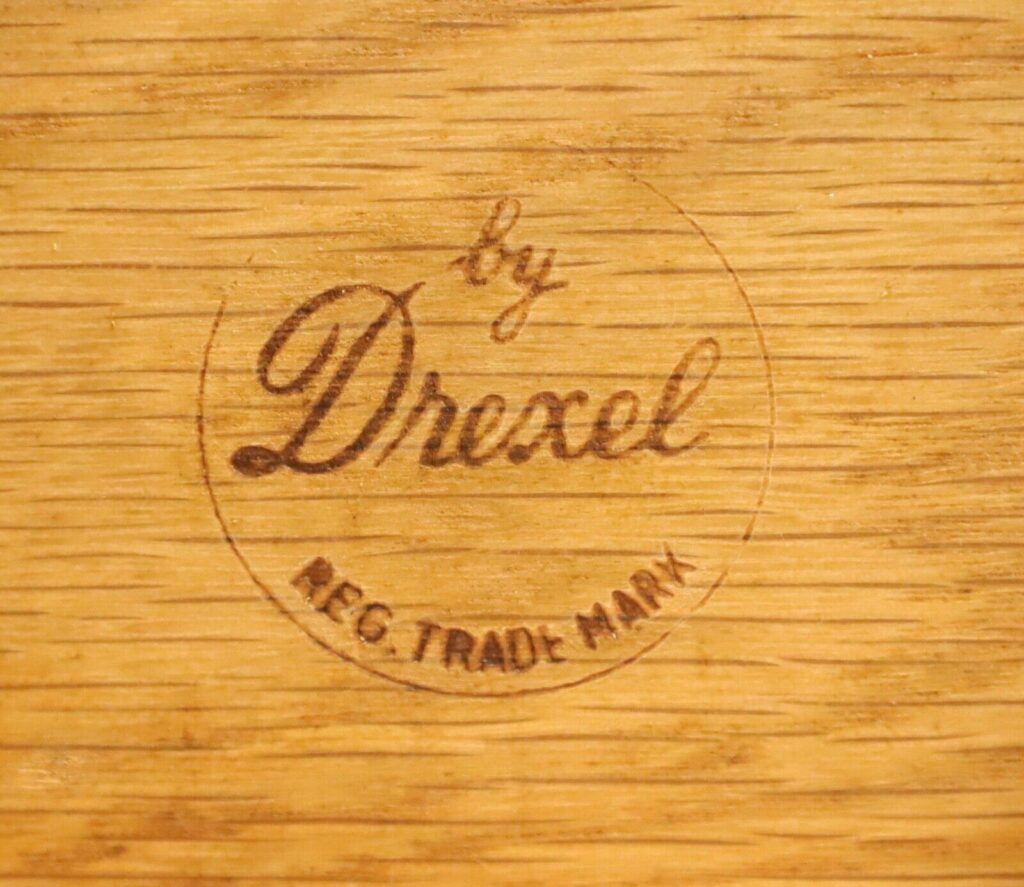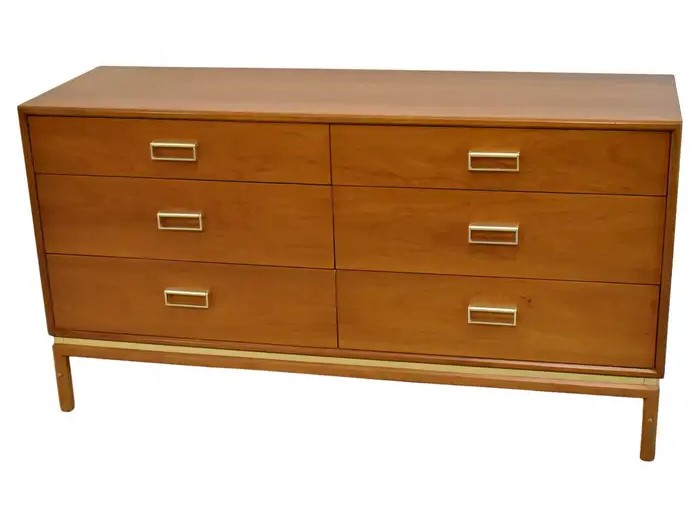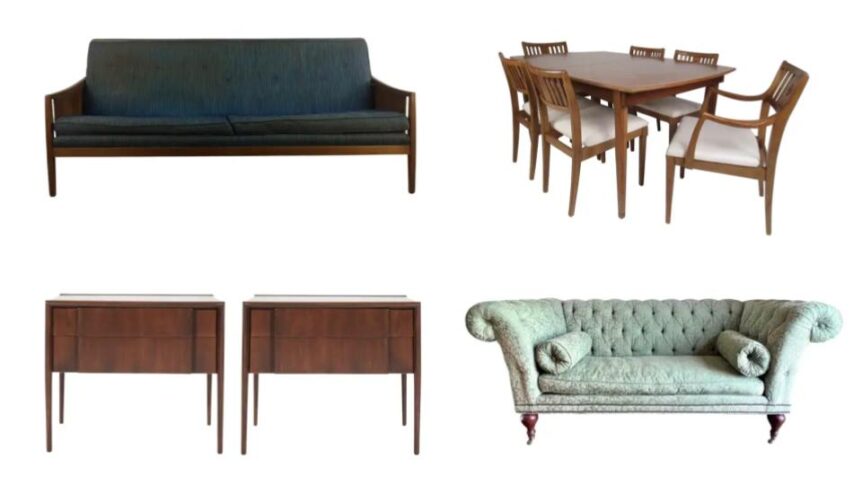Drexel Heritage Furniture: The Epitome of American Mid-Century Design and Craftsmanship

Drexel Heritage is one of the most iconic names in vintage and antique American furniture. Founded in 1903 in Valdese, North Carolina, Drexel Heritage Furniture Company (originally Drexel Furniture Company) rose to become one of the largest manufacturers of high-quality household furnishings in the United States by the 1950s and 60s.
Over its nine-decade history, Drexel produced many classic furniture collections that are highly sought after today by vintage furniture lovers, interior designers, and collectors. Their designs helped define mid-century modern aesthetics in America.
This in-depth guide takes a look at the rich history of this important vintage furniture brand. It explores in detail how to identify authentic Drexel Heritage pieces, from construction and materials to distinguishing marks. For buyers and collectors, the article provides insider tips on where to hunt for treasures, assessing condition and value, and keys to building an investment-worthy Drexel Heritage collection. Practical advice on proper care and restoration is also included to help cherish these vintage pieces for generations to come.
History of Drexel Heritage Furniture Company
The story of Drexel Heritage Furniture Company spans over nine decades of American furniture manufacturing and includes major expansions, mergers, changing styles, and eventual decline. Their evolution as a company closely mirrors wider trends in 20th-century furniture styles.
Early Years and Leadership
The Drexel Furniture Company was founded in 1903 by A.J. Drexel in Valdese, North Carolina. Valdese proved an ideal location with its ready access to lumber and transport routes. A.J. Drexel chose to initially focus on producing high-quality bedroom suites to establish the new company.
The early leadership of A.J. Drexel and his son George Drexel, who took over in 1916, set the course for Drexel’s future growth and reputation for finely made furnishings. George Drexel implemented modern production techniques and emphasized skilled craftsmanship.
Expanding Production and Offerings
By the 1920s, Drexel was gaining acclaim for its bedroom and dining room collections. As the company continued to expand over the next decades, it widened its product lineup to include upholstered seating and occasional furniture. A larger manufacturing facility opened in 1935 to meet growing demand.
Drexel took advantage of America’s post-war economic boom in the 1950s, which fueled growth in the housing and furniture markets. As a well-established manufacturer, Drexel was poised to scale up production during this period.
The Creation of Drexel Heritage
A major turning point came in 1955, when the Drexel Furniture Company was officially incorporated, merging three yearslater,r in 1958 with the Heritage Furniture Company to form Drexel Heritage Furniture Company.
The newly merged entity became a furniture powerhouse, occupying over 2 million square feet of production facilities and ranking as one of the largest residential furniture manufacturers in the United States during the 1960s and 1970s.
The Golden Age of Drexel Heritage
The three decades following the founding of Drexel Heritage Furniture Company marked the golden age of production. Their vast manufacturing capabilities and talented designers enabled them to create high volumes of furniture to meet booming post-war consumer demand.
It was during the 1950s and 1970s that Drexel Heritage released their most enduring and coveted collections. Designs from this era were trendsetters that came to epitomize mid-century modern style with their clean lines, tapered legs, quality craftsmanship, and mix of materials.
Some of Drexel Heritage’s most iconic furniture collections were born during their peak popularity in the 60s and 70s, including…
- French Provincial: launched in 1960, their Continental European-inspired bedroom and dining room pieces proved hugely popular. Drexel’s French Provincial designs featured elegantly curved legs, painted finishes, and ornate hardware.
- Americana: first released in 1962, the Americana collection took colonial American furniture as its inspiration. Windsor chairs, Early American beds and chests were some of the range’s highlights.
- Henredon: acquired by Drexel Heritage in 1965, the Henredon line contributed further English-influenced furnishings with refined detailing and high-quality mahogany. Drexel manufactured Henredon designs alongside their own brands.
Challenges and Decline
By the late 1970s, changing consumer tastes and competition from cheaper foreign furniture imports had brought new struggles for Drexel Heritage. Sales entered a steady decline through the 80s and 90s. A series of ownership changes also characterized this turbulent period.
The company was first sold to Interco in 1979 before being acquired by Levitz Furniture in 1998. After nearly a century of furniture production, Drexel Heritage finally ceased operations in 2001, unable to remain viable in the challenging US furniture manufacturing climate. They closed as one of the last remaining large-scale American residential furniture brands.
While no longer in business, Drexel Heritage’s legacy lives on through their timelessly stylish mid-century furniture creations, which are more coveted than ever by vintage design lovers.
How to identify Drexel furniture
Drexel Heritage furniture is distinguished by certain hallmarks that help identify authentic vintage pieces. While some details varied across their many collections and decades of production, understanding these signature characteristics is invaluable for collectors.
Craftsmanship and Materials
As a high-end manufacturer, Drexel Heritage Furniture displays exemplary craftsmanship and quality materials. Expect finely sanded solid wood pieces or expertly laminated veneers, and seamless joinery. Upholstered items will have neatly tailored and fitted fabric.
The most common woods used throughout Drexel Heritage’s history were American walnut and teak – both quality hardwoods that accept stains and finishes beautifully. The use of mahogany, rosewood, elm, and beech also occurred depending on the furniture line. Upholstery textiles ranged from delicate printed fabrics to rich leather and vinyl.
Finishes on Drexel Heritage case goods run from smooth natural oil treatments to hand-rubbed and sprayed lacquers in shades of dark walnut, cherry or mahogany. Decorous accents like tapered legs, carved details, tailored upholstery and polished hardware all confirm the work of Drexel’s seasoned craftspeople.
Brand Marks


Authentic vintage Drexel Heritage items will feature a brand mark that provides a key indicator of age and provenance. This maker’s mark may include:
- Drexel Heritage Furniture Company stamp
- Drexel Furniture Company ink stamp (pre-1958 merge)
- Paper label with Drexel Heritage’s name and collection
Finding one of these markings helps confirm that a piece of vintage furniture originated from a Drexel Heritage plant and is not a later reproduction. The marks are typically located on drawer interiors, under tabletops, or on the base of chairs.
Mid-Century Styling Hallmarks

Drexel Heritage’s most prized vintage furniture dates from the 1950s–1970s, when their aesthetics personified mid-century ideals. Key styling clues for identifying their mid-century pieces include:
- Slender, tapered legs of solid wood or enameled metal
- Simple, clean lines and minimal ornamentation
- Geometric shapes like circles, rectangles, and triangles
- Subtle organic curves and contours
- Fusion of wood, metal, and upholstery
- Spotlight on craftsmanship and quality finishes
These styling cues distinguish vintage Drexel Heritage from traditional pre-war furniture and later imitations. Their mid-century pieces feel at once elegant yet unfussy.
Notable Furniture Collections
Drexel Heritage’s major furniture collections provide another avenue for identification. Most of their enduringly popular lines, like Henredon, French Provincial, and Americana, have distinct design elements that make them easily recognizable to knowledgeable collectors.
Some details to look for include:
- French Provincial: – Shaped aprons, cabriole legs, scalloped trim, painted finishes
- Americana: – Turned spindle backs, shaped aprons, columnar cabriole legs
- Henredon: – Mahogany frames, caned panels, brass hardware
Of course, Drexel Heritage produced many more collections than their highlights from the 50s-70s, ranging from ornate 18th-century reproductions to sleek contemporary works. Understanding their full range helps accurately identify eras and styles.
Related articles:
- Saga, Sculptra & Brasilia: A Guide To Vintage Broyhill Furniture
- Stag Furniture Ranges – A Look at the Best of British Mid-Century Design
- How To Identify Vintage Henredon Furniture
- How to Identify Vintage Ethan Allen Furniture
Drexel Furniture Catalogs
Drexel Heritage released annual furniture catalogs that serve as valuable collector’s resources for identifying their vintage pieces. These out-of-print Drexel Heritage catalogs showcase all their latest offerings and provide a visual encyclopedia of the brand’s evolution.
Catalogs from the 1950s–1970s, during Drexel’s rise to prominence, make especially fascinating reference guides for aficionados. Details on popular lines and major new collections are revealed. The styling photography captures coveted mid-century flair.
For authentication purposes, catalogs can be handy for pinpointing the year a specific Drexel Heritage collection debuted. Finding an original vintage catalog at a thrift store or antique mall is like striking gold for committed Drexel Heritage collectors.
Here are some notable details found in pivotal Drexel Heritage furniture catalogs over the decades:
- 1950s: Classic mid-century modern bedroom and dining sets, mix of woods with metal and upholstery
- 1960s: Launch of iconic collections like French Provincial and Americana in bold new styles
- 1970s: – Heavily tailored upholstery on sofas and chairs, eclectic groupings with metal and glass
Beyond aiding the identification and dating of pieces, the gorgeous photography and aspirational settings depicted in Drexel Heritage’s vintage catalogs ignite desire for bringing this mid-century style into one’s own home.
Caring for and Restoring Drexel Heritage Furniture
Proper care and maintenance help preserve vintage Drexel Heritage furniture for generations of enjoyment. When issues emerge, sensitive restoration pays tribute to their original craftsmanship.
Caring for Your Vintage Drexel Heritage Pieces
Daily care for cherished Drexel Heritage furniture involves:
- Gentle dusting using a clean, soft lint-free cloth to remove surface particulates.
- Immediately wiping spills on wood surfaces using a damp cloth followed by drying. Avoid wetting upholstery.
- Using felt floor protectors under legs along with cups and coasters to prevent scratches and water marks.
- Positioning pieces away from direct sunlight to minimize fading and drying of wood.
- Maintaining moderate humidity between 30-50% in the room through humidifiers or dehumidifiers to prevent wood movement and cracking.
- Polishing wood surfaces monthly with furniture wax or polish specifically formulated for fine woods. Avoid oil treatments.
- Vacuuming upholstery lightly using proper attachments, then spot cleaning stains with a mild cleaner approved for vintage fabrics.
Restoring Vintage Drexel Heritage Furniture
Despite diligent care, some antique Drexel Heritage pieces will inevitably require restoration work at some point whether light refreshing or extensive repairs.
Common minor repairs include:
- Tightening loose joints using clamps and wood glue along seams or inside drawers
- Disguising light finish scratches with a wood furniture marker followed by paste wax
- Touching up color loss on painted accents using artist acrylic paints matched to the original hue
- Replacing tarnished hardware like knobs and pulls with period-appropriate ones in shiny chrome or brass
More involved restoration projects demand experience:
- Full refinishing due to extensive surface damage or discoloration
- Re-veneering peeled or missing veneer wood panels
- Re-staining faded or bleached surfaces – potentially tricky to color match original stain
- Re-upholstering worn or damaged seat cushions and backs
- Repairing broken frames, cracked veneers or replacing missing pieces
Knowing when to call in a seasoned professional furniture restorer is wise if repairs exceed your skill level. Drastic DIY attempts often destroy vintage value. Sensitive restoration performed by experts honors the original craftsmanship and beauty.
Related articles:
Related Questions
Below are answers to some common questions related to Drexel Heritage furniture:
What Kind of Wood Is Drexel Furniture Made Of?
Drexel Heritage utilized quality hardwoods for most of their signature vintage furniture collections. The most frequently used species were:
- American Black Walnut – Highly prized for its rich brown coloration and flowing grain pattern. Walnut was extensively used across Drexel Heritage’s bedroom, dining and occasional furniture, especially during the 1950s and 1960s. It stains beautifully while maintaining distinct wood grain visibility.
- Teak – Imported teak wood was another Drexel Heritage favorite thanks to its strength, straight grain and golden-brown patina when finished. Teak was often used for dining chairs and case goods. Its natural oil content allows it to be easily maintained.
- Mahogany – For their Henredon line and other higher-end pieces, Drexel Heritage selected African mahogany for its refined yet durable qualities. Its reddish-brown tones and flowing grain patterns complemented classical styling.
- Other woods – Select furniture collections also featured maple, rosewood, elm, beech and pecan for accents. However, walnut and teak predominated their vintage designs.
In addition to solid woods, Drexel Heritage was expert at utilizing wood veneers over substrates like MDF to allow for larger surface areas while optimizing expensive lumber.
Is Drexel Furniture Valuable?
Drexel Heritage furniture from the mid-20th century heyday of production can carry considerable value thanks to fine materials, quality craftsmanship, and popularity amongst collectors. However, prices vary widely based on factors like:
- Desirability of the furniture line – Iconic collections from Drexel Heritage’s vintage era like Henredon, French Provincial, and Americana command premium auction prices due to high demand from collectors. More common lines tend to appraise lower.
- Year of production – Key mid-century era pieces produced in the 1950s and 1960s at the height of Drexel Heritage’s manufacturing prominence often appraise higher than later productions.
- Condition – Pieces in completely original excellent condition or expertly restored vintage condition achieve top dollar pricing. Significant wear, damage, or improper repairs negatively impact values.
- Rarity – One-of-a-kind custom Drexel Heritage designs ordered by specific clients along with unusual colors, finishes or materials have added value for their uniqueness. Common mass production models appraise lower.
- Provenance – Clear documentation like original catalogs, tags, stamps or invoices proving model names, years of production, and origins from Drexel Heritage factories increase collectibility and values. Lack of provenance reduces worth for collectors and investors.
- Quality materials – Use of finer woods like American black walnut and imported mahogany, along with high-end veneers, hardware and upholstery textiles increase valuations over pieces with more standard materials.
- Current market trends – The appetite of collectors helps drive pricing, with global interest in Mid-Century Modern design keeping demand and prices for vintage Drexel Heritage high currently. This trend could shift over time.
For common case goods like dressers and nightstands, average auction values in very good vintage condition typically start around $500-1000, with exceptional examples reaching $3000 or more. Rare, special-order pieces in pristine condition can potentially fetch five figures in today’s market from dedicated Drexel Heritage collectors.
Where To Buy Drexel Furniture
Top places to find vintage Drexel Heritage furniture include:
- Estate sales & auctions – Can yield hidden gems but expect competition from other buyers.
- Online auctions – eBay, LiveAuctioneers, etc. allow searching for Drexel Heritage pieces currently up for auction.
- Online marketplaces – Facebook Marketplace, Craigslist, Etsy. Great for local finds.
- Antique stores & malls – Call ahead to ask if they have any Drexel Heritage in stock. Be prepared to pay premium pricing.
- Mid-century vintage furniture stores – Will offer the widest selection but often have high price tags.
- Classified ads – Check local ads in newspapers and bulletin boards.
With the popularity of mid-century collecting, finding deals on Drexel Heritage grows increasingly challenging. But patient, persistent hunters may uncover overlooked treasures.
See Drexel Furniture on 1stDIBS
Conclusion
For almost a century, starting in 1903, Drexel Heritage Furniture Company crafted some of the finest residential furnishings available in America. Their high-quality, mid-century modern creations are now icons of vintage style, coveted globally by design enthusiasts.
Studying their story reveals how Drexel Heritage’s evolution as a company traces wider trends in 20th-century furniture fashions. Their early commitment to skilled workmanship combined with later embrace of clean-lined mid-century style created a rich catalog of timeless, sought-after designs.
For collectors seeking investment-worthy vintage furniture, Drexel Heritage’s creations from the 1940s-1970s offer tremendous appeal. Their iconic collections, from Henredon to French Provincial and era-defining styling make authentic Drexel Heritage pieces both artistic and financial assets to those with passion for the past.
With some basic care and maintenance, vintage Drexel Heritage furniture can be cherished for generations to come. From sleek sideboards to sculptural seating, their mid-century forms will continue inspiring interior designers and delighting aficionados well into the future.
Hopefully, this detailed overview provides helpful insider guidance into collecting and caring for Drexel Heritage furniture – one of America’s vintage icons revered for outstanding craftsmanship and design. Please leave any comments or questions below!
Sources:
- Heritage Home Group. (2023, April 9). In Wikipedia. https://en.wikipedia.org/wiki/Heritage_Home_Group


